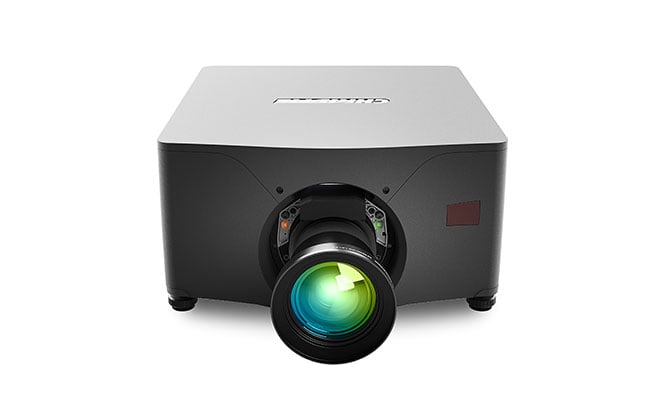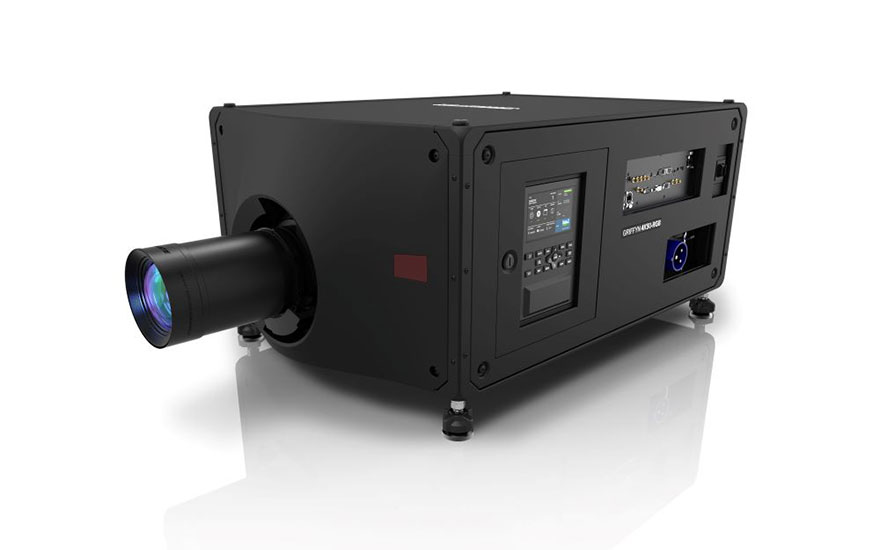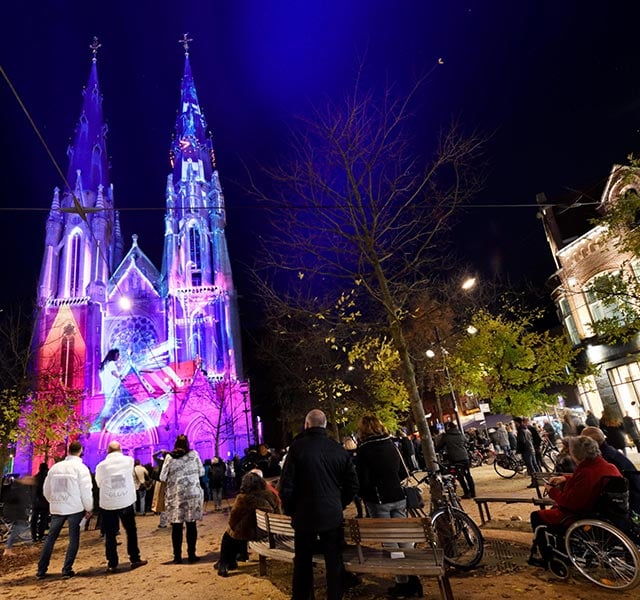We’re diving into DLP projectors, how they work, and their advantages
At Christie, we commonly refer to many of our projectors as 1DLP or 3DLP. But what does that mean? In this post, we’ll dive into DLP projectors, their advantages, and the differences between 1DLP, or 1-chip, and 3DLP, or 3-chip, to help you select the right projection solution for your next project.
Key Takeaways:
- A DLP (Digital Light Processing) projector uses microscopic mirrors to create crisp, sharp images with better color uniformity.
- 1DLP vs. 3DLP: 1DLP projectors use a single chip and color wheel for color, while 3DLP projectors use three chips — one for each primary color — for superior image quality.
- RGB pure laser projectors offer the highest brightness and color gamut, reaching up to 98% of the Rec. 2020 standard.
- Laser phosphor and lamp-based projectors each provide projection solutions depending on cost, maintenance, and brightness needs.
- Christie’s DLP projector lineup supports a wide variety of applications — from cinemas to live events and large venues to museums and corporate settings.
DLP projectors explained
DLP stands for Digital Light Processing. Developed by Texas Instruments®, DLP projectors use chips called DMDs (Digital Micromirror Devices), which use millions of microscopic reflection mirrors — one for each pixel in an image.

optically converge to produce a single, full-color image.
Each mirror can be individually controlled to tilt back and forth rapidly, in an on or off position. When a mirror tilts toward the light source, it reflects light onto the projection surface and creates a bright pixel. When it tilts away from the light source, it reflects light away and creates a dark pixel.
Why DLP?
Texas Instruments sold its first DLP chipset in the mid-1990s and has produced more than 40 million since. They're used in a myriad of technologies including projection, lighting, headlights, and 3D printers.
There’s a reason DLP is so in demand – it’s a proven, reliable, and versatile technology. And in projection, the advantage of an all-digital system like DLP is that it consistently offers better light efficiency and color control than any other projection technology. Individual pixel control results in a smoother, cleaner image, as well as superior color uniformity and sharper imagery with their higher pixel fill factor. DLP projectors also offer higher brightness from even small units while also using less power.
1DLP projectors
As the name suggests, 1DLP laser projectors use just one DLP® chip (or DMD) and a color wheel to generate colors. The white light from the projector's light source passes through a rapidly spinning color wheel that contains red, green, and blue filters. As the wheel spins, the light filters sequentially through each color segment and is directed onto the DMD chip. Rapidly modulating mirrors that synchronize with the color wheel allows DLP projectors to produce a wide spectrum of colors.
3DLP projectors
On the other hand, 3DLP projectors use three DMD chips: one for each primary color of light — red, green, and blue — which optically converge to produce a single, full-color image. Because each DMD is dedicated to a primary color – red, green, and blue – 3DLP projectors don’t use a color wheel.

A DLP projector with Full HD resolution (1920 pixels wide x 1080 pixels high) uses either one or three DMD chips (1DLP or 3DLP) made up of 1,080 rows of mirrors, with each row containing 1,920 microscopic mirrors. At the other end of the resolution spectrum, a Native 4K projector (4096 x 2160 pixels) uses 4,096 rows of mirrors with 2,160 microscopic mirrors.
How light sources work in DLP projectors
DLP technology is found in projectors with different light sources, including RGB pure laser, laser phosphor, or lamp-based light source.
RGB pure laser
RGB pure laser projectors lead the AV industry with superior color, image quality, and brightness up to 50,000 lumens. With individual red, green, and blue laser light sources, they best reproduce real-world colors – they can reach 98% of the Rec. 2020 color gamut. The wide color gamut makes content appear brighter and with greater contrast.

The CIE 1931 chart represents all the colors humans can see.
Laser phosphor
Laser phosphor-illuminated projectors use blue laser diodes as their primary light source, which shine onto a spinning yellow phosphor wheel. The light emitted from the wheel is separated into red and green, while the blue light passes directly through a segment in the wheel. Advanced laser phosphor projectors use a direct red laser diode to boost the low output of red and produce better overall saturation and realistic color.
Lamps
With 1DLP lamp-based projectors, which typically use mercury lamps, white light passes from the lamp through the color wheel that contains red, green, and blue filters. As the wheel spins, the light is sequentially filtered through each color segment and directed onto the DMD chip. In 3DLP lamp-based projectors, which typically use Xenon lamps, broad spectrum xenon light passes through the optical system where the "white light" is separated into red, green, and blue via dichroic filters in the prism, and recombined at the output of the prism to create a picture. Lamp-based illumination is proven reliable, has a low upfront cost, and has well-understood maintenance schedules.
DLP projectors for exceptional experiences
3DLP offers superior image quality, but 1DLP projectors are edging closer and closer to 3DLP performance: their brightness capabilities are increasing, 4K UHD resolution is becoming more common, contrast levels are improving, and color reproduction is getting better and better.
When you see massive projections on the side of a building, lifelike images mapped onto non-traditional canvases, or large-scale live events, this is most likely 3DLP projection in action. With a 3DLP projector, you also typically have higher frame rate options for superior dynamic image quality.
And when it comes to brightness, contrast, hue, and saturation, 3DLP projectors are the best in the industry.
You can connect with us on social media to stay up to date on the newest projects and products.
Have any questions?
Frequently asked questions
What is a DLP projector?
Digital Light Processing, or DLP projectors, use microscopic mirrors on a DMD chip to reflect light and create high-resolution digital images.
How long does a DLP projector last?
3DLP projectors achieve the highest brightness levels possible in projection.
Are DLP projectors brighter than other projectors?
An RGB pure laser 3DLP projector can run at maximum brightness for 25,000 hours before reaching 50% brightness. Laser phosphor DLP projectors can run for 20,000 hours before reaching 50% brightness. Running a DLP projector in eco-mode will increase the lifespan of the projector’s light source.
Which is better - 3LCD vs. DLP projectors?
Although recent advancements in 3LCD technology mean considerably improved image quality, DLP projectors typically produce deeper blacks than 3LCD projectors. They also offer superior color uniformity and produce sharper imagery with their higher pixel fill-factor.
3LCD projection technology is still an extremely cost-effective option for customers looking for a reliable, long-life projector that produces bright visuals and accurate colors.
What’s the difference between a 1DLP projector and a 3DLP projector?
1DLP projectors use a single chip and a color wheel, while 3DLP projectors use three chips—one for each primary color—for superior color accuracy and brightness.
What are the advantages of DLP projectors?
DLP projectors deliver sharp, uniform images with high brightness and low power consumption thanks to precise digital control of each pixel.
Which DLP projector type is best for large-scale events?
3DLP projectors are ideal for large-scale events and projection mapping due to their superior image quality, color depth, and high frame rate support.



